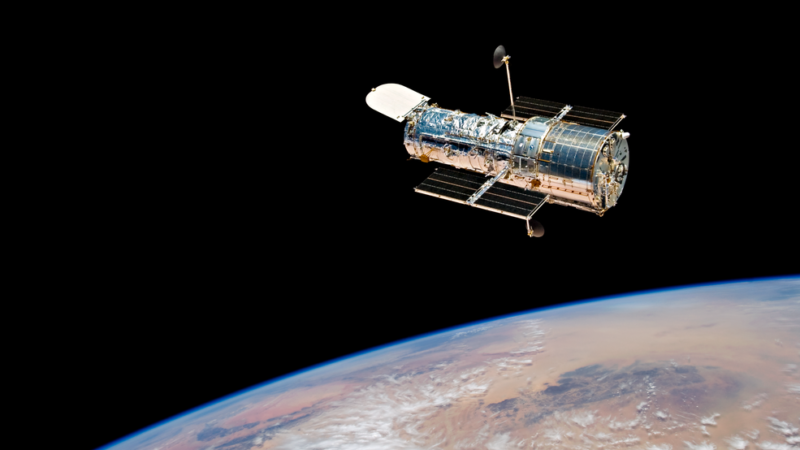The venerable Hubble Space Telescope is running out of gyroscopes, and when none are left, the instrument will cease to conduct meaningful science.
To preserve the telescope, which has been operating in space for nearly three and a half decades, NASA announced Tuesday that it will reduce the Hubble's operations such that it will function on just a single gyroscope. This will limit some scientific operations, and it will take longer to point the telescope to new objects and lock onto them.
But in a conference call with space reporters, Hubble officials stressed that the beloved scientific instrument is not going anywhere anytime soon.
"I don’t personally see this as a major restriction on its ability to do science," said Mark Clampin, director of the Astrophysics Division at NASA headquarters in Washington, DC.
From six to one
The Hubble telescope was launched on NASA's space shuttle in 1990, and since then, the space agency has flown five servicing missions to repair and upgrade the complex instrument. To this day, it offers humanity its best view of the Universe in the visible light range of the spectrum.
The last of these servicing missions, flown by space shuttle Atlantis in 2009, performed numerous upgrades, including the replacement of all six gyroscopes that help to orient and point the telescope. However, in the 15 years since then, three of the six gyroscopes have failed. In the last six months, another one, "gyro 3," has increasingly returned faulty data. This has caused Hubble to slip into safe mode multiple times, halting science operations.
As a result, the space agency has just two fully functional gyroscopes. One of these, gyro 4, has operated for a total of 142,000 hours. Another, gyro 6, has accumulated 90,000 hours. NASA's plan is to now operate the telescope on a single gyroscope, keeping the second one as a "reserve" option.
NASA said operating on a single gyroscope is feasible, with relatively modest implications for observing capabilities. It will be less efficient, requiring more time to point. This will result in a loss of about 12 percent of observation time. The telescope will also be unable to observe objects closer than Mars, including Venus and the Moon.
However, by taking this step now, the space agency believes it can extend Hubble's operational lifetime for another decade. The telescope's project manager, Patrick Crouse, said there is a 70 percent chance that Hubble can maintain science operations using a single gyroscope through 2035.
"We do not see Hubble as being on its last legs," he said Tuesday.
From a scientific standpoint, it is important for Hubble to keep operating. Now that the powerful James Webb Space Telescope is operational, the two instruments are an amazing duo. With Hubble observing in visible light and Webb in the infrared, astronomers can glean valuable new insights about the nature of the Universe.
Another servicing mission? No thanks
In addition to aging science instruments and a decreasing number of gyroscopes, NASA also faces some other challenges regarding the lifetime of the instrument. The telescope has typically operated at an altitude between 615 km and 530 km above the surface of the Earth. However, the telescope will likely fall below 500 km sometime this year. At lower altitudes, some of the telescope's observations are being impacted by other satellites in low-Earth orbit.
Clampin said Tuesday that the telescope operators do not forecast that Hubble will re-enter Earth's atmosphere before the mid-2030s. That, combined with the gyroscope limit, would seem to set to firm boundary on Hubble's maximum lifetime remaining.
However, in 2022, Jared Isaacman, a billionaire who flew the first fully commercial human mission to orbit aboard Crew Dragon, approached NASA about performing a servicing mission to the Hubble Space Telescope. He proposed to fund most of the mission which, at a minimum, would have re-boosted the Hubble Space Telescope by at least 50 km.
After NASA and SpaceX conducted a feasibility study late that year it was recommended that the space agency continue investigating the possibility of a commercial mission. At a minimum it could safely re-boost the telescope, but there were also options that including attaching star trackers and external gyroscopes to compensate for the telescope's ailing pointing system.
But NASA decided not to pursue the option.
"Our position right now is that, after exploring the current commercial capabilities, we are not going to pursue a re-boost straight now," Clampin said Tuesday.
Asked about the study, which NASA has declined to release for proprietary reasons, Clampin said, "It was a feasibility study to help us understand some of the issues and challenges that we might have to face," he said. "There were options such as the possibility of doing enhancements by adding gyros to the outside of the telescope, but they were really just notional concepts."
NASA has evidently decided that it is safer to let Hubble age out on its own, than take a chance on private hands touching the hallowed telescope. We're about to see how that goes.



3175x175(CURRENT).thumb.jpg.b05acc060982b36f5891ba728e6d953c.jpg)

Recommended Comments
There are no comments to display.
Join the conversation
You can post now and register later. If you have an account, sign in now to post with your account.
Note: Your post will require moderator approval before it will be visible.